
Versailles • Chartres • Giverny • Disneyland Paris
Map: Domaine de Marie-Antoinette
Map: Versailles Town Hotels & Restaurants
Sleeping and Eating in Giverny
Efficient trains bring dozens of day trips within the grasp of temporary Parisians. Europe’s best palace at Versailles, the awesome cathedral of Chartres, the flowery gardens at Giverny that inspired Monet, and a mouse-run amusement park await the traveler looking for a refreshing change from urban Paris.
Every king’s dream, Versailles (vehr-“sigh”) was the residence of French monarchs and the cultural heartbeat of Europe for about 100 years—until the Revolution of 1789 changed all that. The Sun King (Louis XIV) created Versailles, spending freely from the public treasury to turn his dad’s hunting lodge into a palace fit for the gods (among whom he counted himself). Louis XV and Louis XVI spent much of the 18th century gilding Louis XIV’s lily. In 1837, about 50 years after the royal family was evicted by citizen-protesters, King Louis-Philippe (then a constitutional monarch rather than a divine one) opened the palace as a museum. Today you can visit parts of the huge palace and wander through acres of manicured gardens sprinkled with fountains and studded with statues. Europe’s next-best palaces are just Versailles wannabes.
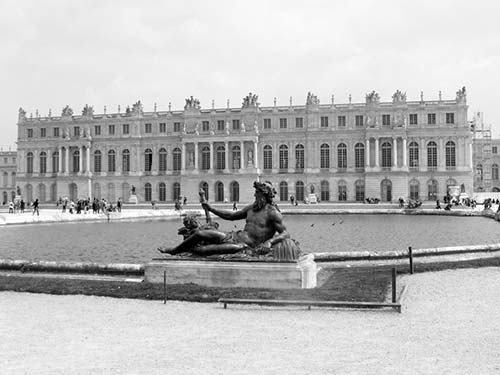

Worth ▲▲▲, Versailles offers three blockbuster sights. The main attraction is the palace itself, called the Château. Here you walk through dozens of lavish, chandeliered rooms once inhabited by Louis XIV and his successors, starring the magnificent Hall of Mirrors. Next come the expansive Gardens behind the palace, a landscaped wonderland crossed with footpaths and dotted with statues and fountains. Finally, at the far end of the Gardens, is the pastoral area called the Trianon Palaces and Domaine de Marie-Antoinette (a.k.a. Trianon/Domaine), a vast walled enclosure designed for frolicking blue bloods and featuring several small palaces and Marie’s Hamlet—perfect for getting away from the mobs at the Château.
Visiting Versailles can seem daunting because of its size and hordes of visitors. But if you follow my tips, a trip here during even the busiest times is manageable.
By Train: The town of Versailles is 35 minutes southwest of Paris. Take RER/Train-C from any of these stations: Gare d’Austerlitz, St. Michel, Musée d’Orsay, Invalides, Pont de l’Alma, or Champ de Mars. Buy a round-trip ticket to “Versailles Rive Gauche/Château” from an easy-to-figure-out ticket machine or ticket window (€7.10 round-trip, credit card or coins, 4/hour). If the ticket machine doesn’t immediately offer a Versailles option, try pressing “Ile de France.” Insert your ticket in the turnstile to enter the system (as you would with the Métro). Then check the departure board, which will list the next train to “Versailles Rive Gauche/Château” and its track.
Board your train and relax. On all Versailles-bound trains, Versailles Rive Gauche/Château is the final stop. Once you arrive, exit through the turnstiles (you may need to insert your ticket). To reach the Château, follow the flow: Turn right out of the station, then left at the first boulevard, and walk 10 minutes.
Returning to Paris: To get back into Paris from the Versailles Rive Gauche/Château train station, just hop on the train at the same train station—all trains from here zip back to the city, stopping at all stations along line C. The monitor above the ticket turnstiles shows how many minutes until the next train leaves and from which track. Remember, your RER/Train-C ticket covers any connecting Métro ride once you’re back downtown.
By Taxi: The 30-minute ride (without traffic) between Versailles and Paris costs about €65.
By Car: Get on the périphérique freeway that circles Paris, and take the toll-free A-13 autoroute toward Rouen. Exit at Versailles, follow signs to Versailles Château, and avoid the hectic Garden lots by parking in the big pay lot at the foot of the Château on Place d’Armes (€4/hour).
Versailles merits a full sightseeing day. In general, allow 1.5 hours each for the Château, the Gardens (includes time for lunch), and the Trianon/Domaine. Add another two hours for round-trip transit, and you’re looking at nearly an eight-hour day. If you have more time to spend at Versailles, consider one of the lesser sights near the palace: the Equestrian Performance Academy (www.acadequestre.fr) or the King’s Vegetable Garden (www.potager-du-roi.fr).
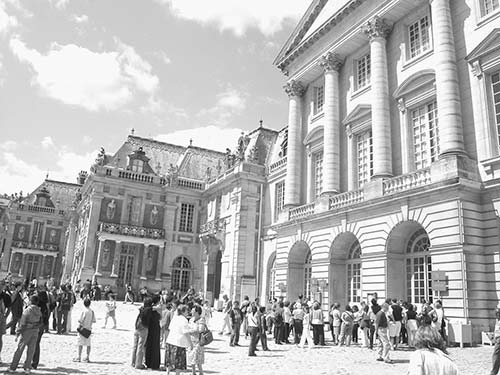
Versailles is all about crowd management; a well-planned visit can make or break your experience. Take this advice to heart. Versailles is much more enjoyable with a relaxed, unhurried approach. Here’s what I’d do on a first visit:
• Get a pass in advance (see “Passes,” later).
• In high season, avoid Sundays, Tuesdays, and Saturdays—in that order—when crowds smother the palace interior. Thursdays and Fridays are best.
• Leave Paris by 8:15, arrive as the palace opens at 9:00, and follow my self-guided tour of the Château interior. Have lunch. Spend the afternoon touring the Gardens and the Trianon Palaces/Domaine de Marie-Antoinette. To shorten your visit, skip the Trianon/Domaine, which takes 1.5 hours to see, plus a 30-minute walk each way.
• An alternate plan is to see the Trianon/Domaine first. Arrive in Versailles around 11:00 and catch the “TRI” shuttle bus from the train station to the Trianon/Domaine (see the “Getting Around the Gardens” sidebar, later) to get there when it opens at noon. Then work your way back through the Gardens to the Château, arriving after the crowds have died down (usually by 14:00, later on Sun).
Cost: Buy either a Paris Museum Pass or a Versailles Le Passeport Pass, both of which give you access to the most important parts of the complex (see “Passes,” next). If you don’t get a pass, buy individual tickets for each of the three different sections.
The Château: €18, includes audioguide, free for kids 17 and under. Free on the first Sunday Nov-March.
The Trianon Palaces and Domaine de Marie-Antoinette: €12, no audioguide, free for kids 17 and under. Covers all the buildings within this walled enclosure. Free on the first Sunday Nov-March.
The Gardens: The gardens are free Wed-Thu and Nov-March, and on other days when there are no Spectacles. You’ll pay on Sat-Sun as well as on many Tue and Fri, when the Spectacles take place (see “Spectacles in the Gardens,” later).
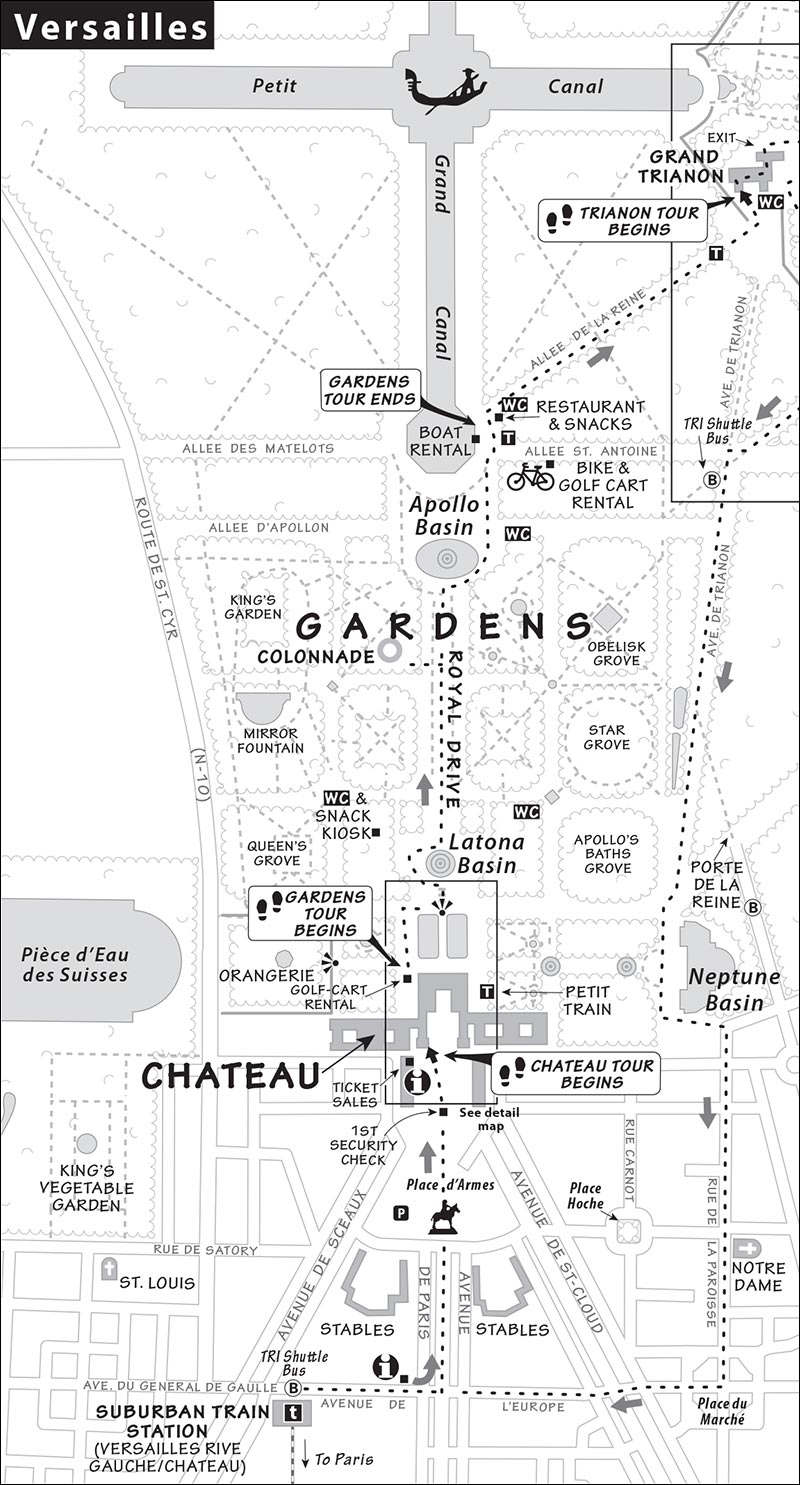


Passes: The following passes can save money and allow you to skip ticket-buying lines (but not security checks).
The Paris Museum Pass (see here) covers the Château and the Trianon/Domaine area (a €30 value) and is the best solution for most. It doesn’t include the Gardens on Spectacle days.
The Le Passeport pass (€20) covers the Château and the Trianon/Domaine area. On Spectacle days, it’s €27. You can add an English language tour for €7.
Hours: The Château is open April-Oct Tue-Sun 9:00-18:30, Nov-March Tue-Sun until 17:30, closed Mon year-round.
The Trianon Palaces and Domaine de Marie-Antoinette are open April-Oct Tue-Sun 12:00-18:30, Nov-March until 17:30, closed Mon year-round (off-season only the two Trianon Palaces and the Hamlet are open, not other outlying buildings), last entry 45 minutes before closing.
The Gardens are open April-Oct daily 8:00-20:30, Nov-March until 18:00, but may close earlier for special events.
Buying Passes and Tickets: Ideally, buy your pass or ticket before arriving at the palace. You can purchase Versailles tickets at any Paris TI, FNAC department store (small fee), or at www.chateauversailles.fr.
If you arrive in Versailles without a pass or a ticket, the GuidaTours office (across from the train station, under the stone arch at #10) sells Château tickets (€18) as well as VIP skip-the-line tickets (€28; you’ll leave with a group from their office, go directly in with the group, then disperse; departures with demand, still some security line wait). I’d consider their VIP tickets on busy days. Skip their €38 guided tour ticket. The Versailles TI also sells tickets (for a fee; near the train station—see “Information,” later).
Your last and (usually) worst option is to buy a pass or ticket at the busy Château ticket-sales office (to the left as you face the palace). Ticket windows accept American credit cards. For the ticket machines (in back) you’ll need bills or a credit card with a PIN.
Crowd-Beating Strategies: Versailles is packed May-Sept 9:30-13:00, so come early or late. Avoid Sundays, Tuesdays, and Saturdays (in that order), when the place is jammed all day. To skip the ticket-buying line, buy a pass or ticket in advance, or book a guided tour. Everyone must go through the same two (often slow) security checkpoints: at the Château’s courtyard entry and again at the Château entrance (longest lines 10:00-12:00). Consider seeing the Château late in the afternoon, when crowds die down.
Pickpockets: Assume pickpockets are working the tourist crowds.
Information: Check the excellent website for updates and special events—www.chateauversailles.fr. The palace’s general contact number is tel. 01 30 83 78 00. You’ll pass the city TI on your walk from the train station to the palace—it’s just past the Pullman Hôtel and sells palace tickets (10 percent fee, open daily 9:00-19:00, Sun until 18:00, shorter hours in winter, free Wi-Fi, tel. 01 39 24 88 88). The information office at the Château is to the left as you face the palace (WCs, toll tel. 08 10 81 16 14).
Tours: The 1.5-hour English guided tour gives you access to a few extra rooms (the itinerary varies) and lets you skip the regular security line (€7, plus €18 palace entry if you don’t have it; generally at least 5 tours in English between 9:00 and 15:00 April-Oct; off-season likely only at 9:30 and 14:00). Book in advance on the palace’s website, or reserve immediately upon arrival at the guided-tours office (to the right of the Château). Tours can sell out by 13:00, though more are usually available than indicated online.
A free and worthwhile audioguide to the Château is included in your admission. Other podcasts and digital tours are available in the “multimedia” section at www.chateauversailles.fr.
 Download my free Versailles audio tour. (Note that my tour and the included palace audioguide complement each other—“A” students enjoy listening to both.)
Download my free Versailles audio tour. (Note that my tour and the included palace audioguide complement each other—“A” students enjoy listening to both.)
Baggage Check: Free and located just after Château entry security. You must retrieve your items one hour before closing (maximum size is same as airlines allow for carry-on bags). Large bags and baby strollers are not allowed in the Château and the two Trianons.
Services: WCs are plentiful and well-signed in the Château, but fewer and farther between in the Gardens.
Eating: To the left of the Château, the $ Grand Café d’Orléans offers good-value self-service meals (sandwiches and small salads, great for picnicking in the Gardens). In the Gardens, you’ll find several cafés and snack stands with fair prices. One is located near the Latona Fountain (less crowded) and others are in an atmospheric cluster at the Grand Canal (more crowds and more choices, including two restaurants).
Across from the train station, there’s a McDonald’s, a Starbucks (both with WCs), and the Ibis hotel’s buffet breakfast (perfect for early birds). In Versailles town center, the best choices are on the lively Place du Marché Notre-Dame, with a supermarket nearby, or along traffic-free Rue de Satory, on the opposite (south) side as you leave the Château.
Spectacles in the Gardens: The Gardens and fountains at Versailles come alive at selected times, offering a glimpse into Louis XIV’s remarkable world. The Sun King had his engineers literally reroute a river to fuel his fountains and feed his plants. Even by today’s standards, the fountains are impressive. Check the Versailles website for current hours and to find out what else might be happening during your visit.
On nonwinter weekends, the Gardens’ fountains are in full squirt. The whole production, called Les Grandes Eaux Musicales, involves 55 fountains gushing for an hour in the morning, then again for about two hours in the afternoon, all accompanied by loud classical music (€9.50; late March-Oct Sat-Sun 11:00-12:00 & 15:30-17:00, Tue mid-May-June 11:00-12:00 & 14:30-16:30, plus some Fri—check www.chateauversailles.fr). Pay at the entrance to the Gardens, unless you’ve bought Le Passeport—in which case you’ve already paid (automatically tacked on to Passeport price on Spectacle days).
Even on high-season Tue and Fri when the fountains don’t run, you still get all-day music with the Les Jardins Musicaux program (€8.50, April-mid-May and July-Oct 10:00-18:30).
On certain summer weekend nights you get the big shebang: Les Grandes Eaux Nocturnes, which presents whimsical lighted displays leading between gushing fountains and a fireworks show over the largest fountain pool (€26-41, mid-June-mid-Sept Sat 20:30-22:40, fireworks at 22:50). On these nights, the Royal Serenade option lets you go into the palace with costumed characters (€42 combo-ticket).
Starring: Luxurious palaces, endless gardens, Louis XIV, Marie-Antoinette, and the ancien régime.
 SELF-GUIDED TOUR
SELF-GUIDED TOUROn this self-guided tour, you’ll see the Château (the State Apartments of the king as well as the Hall of Mirrors), the landscaped Gardens in the “backyard,” and the Trianon Palaces and Domaine de Marie-Antoinette, located at the far end of the Gardens. If your time is limited or you don’t enjoy walking, I give you permission to skip the Trianon/Domaine, which is a hefty 30-minute hike (each way) from the Château.
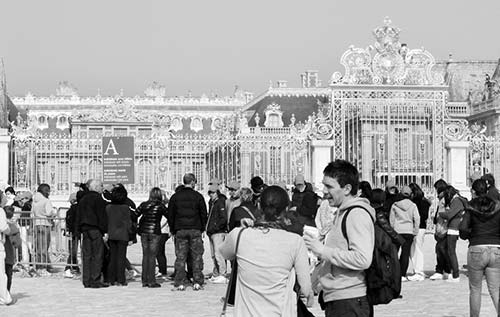
This commentary covers the basics. For background, first read the “Kings and Queens and Guillotines” sidebar. For a detailed room-by-room rundown, consider the guidebook called The Châteaux, the Gardens, and Trianon (sold at Versailles).
• Stand in the huge courtyard and face the palace. The golden Royal Gate in the center of the courtyard—nearly 260 feet long and decorated with 100,000 gold leaves—is a replica of the original. If you don’t already have a pass or ticket, the ticket-sales office is to the left; guided-tour sales are to the right. The entrance to the Château is marked Entrance A (where the line usually is). Before entering (or while standing in line at the entrance), take in the Château and the open-air courtyard on the other side of the golden Royal Gate.
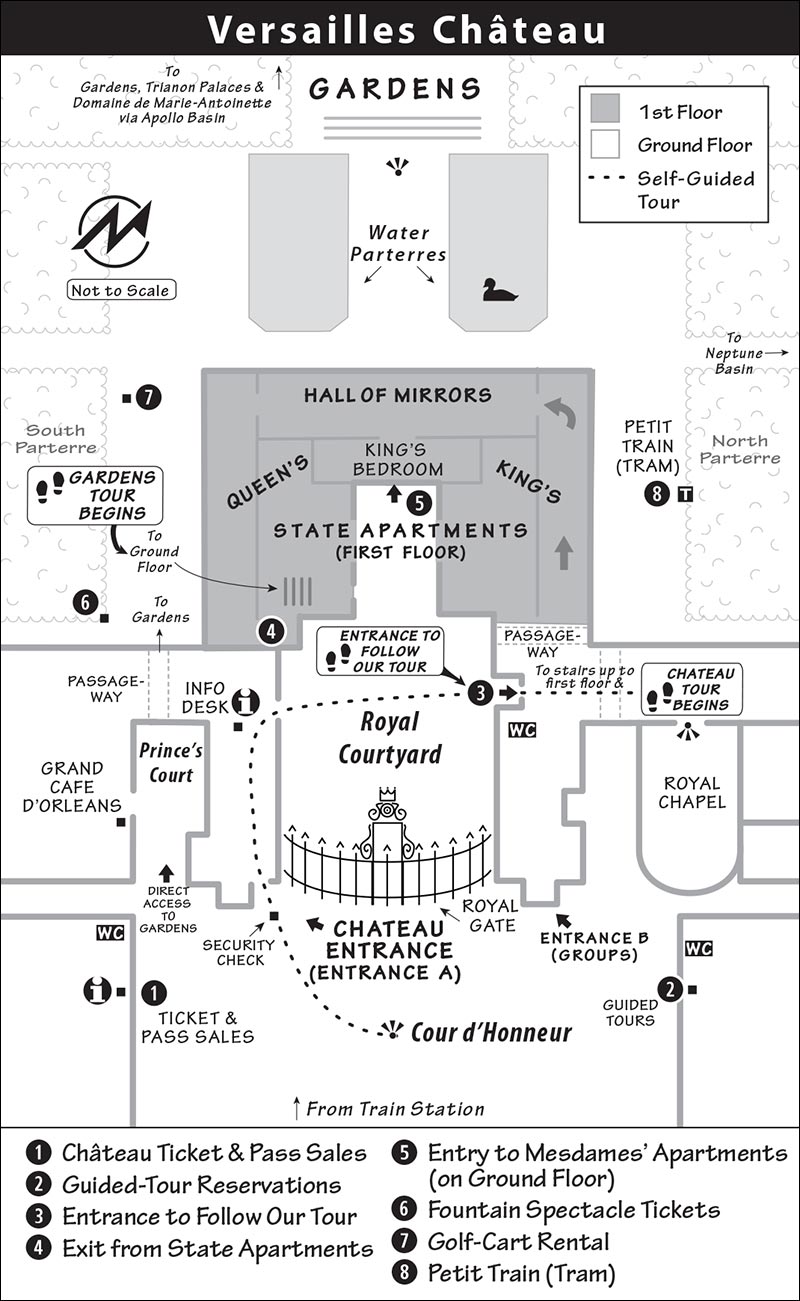
The section of the palace with the clock is the original château, once a small hunting lodge where little Louis XIV spent his happiest boyhood years. Naturally, the Sun King’s private bedroom (the three arched windows beneath the clock) faced the rising sun. The palace and grounds are laid out on an east-west axis.
Once king, Louis XIV expanded the lodge by attaching wings, creating the present U-shape. Later, the long north and south wings were built. The total cost of the project has been estimated at half of France’s entire GNP for one year.
• As you finally enter the Château, you’ll find an information desk (get a map) and bag check. Follow the crowds directly across the courtyard, where you’ll go back inside and line up for your free (and worth-the-wait) audioguide. Now make your way to the start of our tour.
On the way, you’ll pass through a dozen ground-floor rooms. The first offers a glimpse through a doorway at the impressive Royal Chapel, which we’ll see again upstairs. Later rooms have videos of palace history, models of Versailles at different stages of growth, and paintings of Louis XIV, XV, and XVI. Climb the stairs and keep following the flow. You’ll eventually reach a palatial golden-brown room, with a doorway that overlooks the Royal Chapel. Let the tour begin.
Royal Chapel: Dut-dutta-dah! Every morning at 10:00, the organist and musicians struck up the music, these big golden doors opened, and Louis XIV and his family stepped onto the balcony to attend Mass. While Louis looked down on the golden altar, the lowly nobles on the ground floor knelt with their backs to the altar and looked up—worshipping Louis worshipping God. Important religious ceremonies took place here, including the marriage of young Louis XVI to Marie-Antoinette.
• Enter the next room, an even more sumptuous space with a fireplace and a colorful painting on the ceiling.
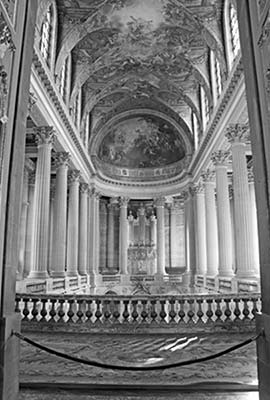
Hercules Drawing Room: Pleasure ruled. The main suppers, balls, and receptions were held in this room. Picture elegant partygoers in fine silks, wigs, rouge, lipstick, and fake moles (and that’s just the men) as they dance to the strains of a string quartet.
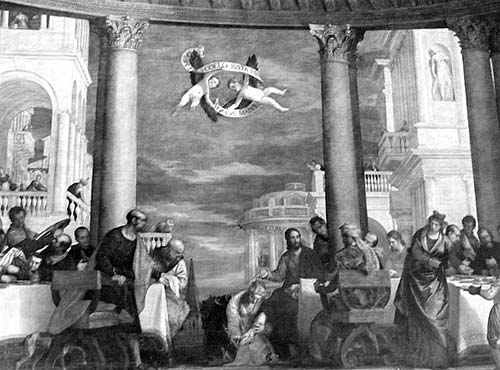
On the wall opposite the fireplace is an appropriate painting showing Christ in the middle of a Venetian party. The work—by Paolo Veronese, a gift from the Republic of Venice—was one of Louis XIV’s favorites, so the king had the room decorated around it.
• From here on it’s a one-way tour—getting lost is not allowed.
The King’s Wing: The names of the rooms generally come from the paintings on the ceilings. For instance, the Venus Room was the royal make-out space, where couples would cavort beneath the goddess of love, floating on the ceiling. In the Diana Room, Louis and his men played pool on a table that stood in the center of the room, while ladies sat surrounding them on Persian-carpet cushions, and music wafted in from next door. Louis was a good pool player, a sore loser, and a king—thus, he rarely lost.
Also known as the Guard Room (as it was the room for Louis’ Swiss bodyguards), the Red Room is decorated with a military flair. The Mercury Room may have served as Louis’ official (not actual) bedroom, where the Sun King would ritually rise each morning to warm his subjects. The Apollo Room was the grand throne room. Louis held court from a 10-foot-tall, silver-and-gold, canopied throne on a raised platform placed in the center of the room (the platform is there, though not the throne). Even when the king was away, passing courtiers had to bow to the empty throne.
The final room of the King’s Wing is the War Room, depicting Louis’ victories—in marble, gilding, stucco, and paint.
• Next you’ll visit the magnificent...
Hall of Mirrors: No one had ever seen anything like this hall when it was opened. Mirrors were still a great luxury at the time, and the number and size of these monsters was astounding. The hall is nearly 250 feet long. There are 17 arched mirrors, matched by 17 windows letting in that breathtaking view of the Gardens. Imagine this place lit by the flames of thousands of candles, filled with ambassadors, nobles, and guests dressed in silks and powdered wigs. At the far end of the room sits the king, on the canopied throne moved in temporarily from the Apollo Room. Servants glide by with silver trays of hors d’oeuvres, and an orchestra fuels the festivities. The mirrors reflect an age when beautiful people loved to look at themselves.

In another age altogether, Germany and the Allies signed the Treaty of Versailles, ending World War I (and, some say, starting World War II) right here, in the Hall of Mirrors.
• Midway down the Hall of Mirrors, you’ll be routed to the left through the heart of the palace, to the...
King’s Bedroom and Council Rooms: Louis XIV’s bedroom is elaborately decorated, and the decor changed with the season. Look out the window and notice how this small room is at the exact center of the immense horseshoe-shaped building, overlooking the main courtyard and—naturally—facing the rising sun in the east. It symbolized the exact center of power in France.
• This ends our tour of the Chateau. The Queen’s Wing of the Château will most likely be closed when you visit due to extensive renovation. (If it’s open, consider it a bonus; you’ll pass through an additional half-dozen sparkling rooms where France’s queens had their apartments.) Otherwise, from here you’ll make your way toward the exit, passing through several unremarkable rooms (all described in the included audioguide).
Louis XIV was a divine-right ruler. One way he proved it was by controlling nature like a god. These lavish grounds—elaborately planned, pruned, and decorated—showed everyone that Louis was in total command. Louis loved his gardens and, until his last days, presided over their care. He personally led VIPs through them and threw his biggest parties here. With their Greco-Roman themes and incomparable beauty, the Gardens further illustrated his immense power.
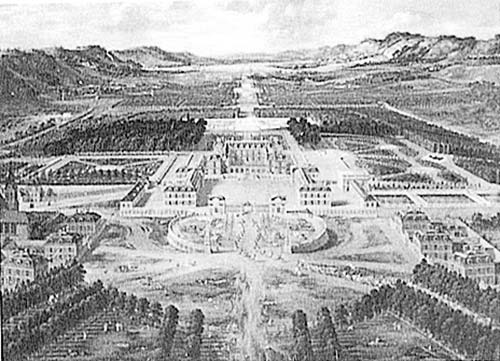
The Gardens are vast. For some, a stroll through the landscaped shrubs around the Château and quick view down the Royal Drive is plenty. But it’s worth the 10-minute walk down the Royal Drive to the Apollo Basin and back (even if you don’t continue further to the Trianon/Domaine). To trace the route of this tour, see the “Versailles” map earlier in this chapter.
As you walk, consider that a thousand orange trees were once stored beneath your feet in greenhouses. On sunny days, they were wheeled out in their silver planters and scattered around the grounds. The warmth from the Sun King was so great that he could even grow orange trees in chilly France.
With the palace behind you, it seems as if the grounds stretch out forever. Versailles was laid out along an eight-mile axis that included the grounds, the palace, and the town of Versailles itself, one of the first instances of urban planning since Roman times and a model for future capitals, such as Washington, DC, and Brasilia. A promenade leads from the palace to the Grand Canal, where France’s royalty floated up and down in imported Venetian gondolas.
(See “Domaine de Marie-Antoinette” map.)
Versailles began as an escape from the pressures of kingship. But in a short time, the Château became as busy as Paris ever was. Louis XIV needed an escape from his escape, so he built a smaller palace out in the boonies. Later, his successors retreated still farther from the Château and French political life, ignoring the real world that was crumbling all around them. They expanded the Trianon area, building a fantasy world of palaces, ponds, pavilions, and pleasure gardens—the enclosure called Marie-Antoinette’s Domaine.
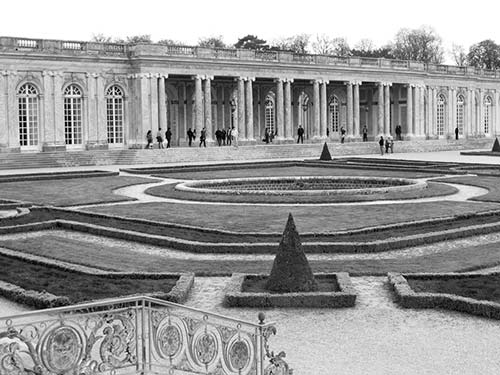
Grand Trianon: Delicate, pink, and set amid gardens, the Grand Trianon was the perfect summer getaway. This was the king’s private residence away from the main palace. Louis XIV usually spent a couple of nights a week here (more in the summer) to escape the sniping politics, strict etiquette, and 24/7 scrutiny of official court life.
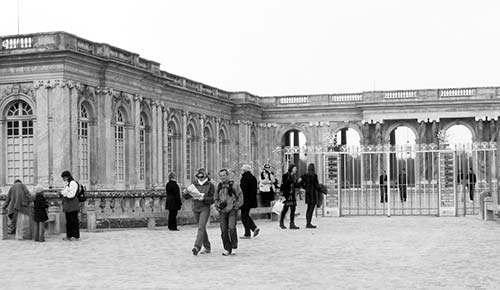
Louis XIV built the palace (1670-1688) near the tiny peasant village of Trianon (hence the name) and faced it with blue-and-white ceramic tiles. When those began disintegrating almost immediately, the palace was renovated with pink marble. It’s a one-story structure of two wings connected by a colonnade, with gardens in back.
• To enter the Grand Trianon, you must first pass through its security checkpoint. Pick up the free palace brochure and follow the simple one-way route through the rooms.
The rooms are a complex overlay of furnishings from many different kings, dauphins, and nobles who lived here over the centuries. Louis XIV alone had three different bedrooms. Concentrate on the illustrious time of Louis XIV (1688-1715) and Napoleon Bonaparte (1810-1814). Use your map to find the Mirror Room, Louis XIV’s Bedchamber, the Emperor’s Family Drawing Room, and the Malachite Room (Napoleon’s living room).
Domaine de Marie-Antoinette: Near the Grand Trianon are the French Pavilion (small cream-colored building where Marie-Antoinette spent summer evenings with family and a few friends), Marie-Antoinette’s Theater, and the octagonal Belvedere palace.
You’ll find the Hamlet 10 minutes past the Belvedere palace. Marie-Antoinette longed for the simple life of a peasant—not the hard labor of real peasants, who sweated and starved around her, but the fairy-tale world of simple country pleasures. She built this complex of 12 thatched-roof buildings fronting a lake as her own private “Normand” village. The main building is the Queen’s House—actually two buildings connected by a wooden skywalk. It’s the only one without a thatched roof. Like any typical peasant farmhouse, it had a billiard room, library, elegant dining hall, and two living rooms.


After touring the Hamlet, head back toward the Petit Trianon. Along the way (in about five minutes), you’ll see the white dome of the Temple of Love. The gray, cubical Petit Trianon from the 1760s is a masterpiece of Neoclassical architecture, built by the same architect (Ange-Jacques Gabriel) who created the Opera House in the main palace. It has four distinct facades, each a perfect and harmonious combination of Greek-style columns, windows, and railings.
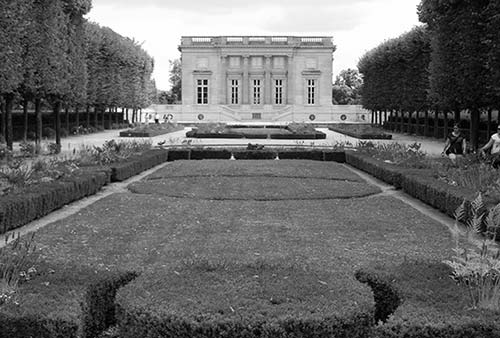
Louis XV built the Petit Trianon as a place to rendezvous with his mistress Madame de Pompadour. He later gave it to his next mistress, Countess du Barry. After the crown passed to Louis XVI, it became the principal residence of Marie-Antoinette, who was uncomfortable with the court intrigue in the big Château. As you tour the Petit Trianon, you’ll see portraits and historical traces of this intriguing cast of characters.
Marie-Antoinette made the Petit Trianon her home base. On the lawn outside, she installed a carousel. Despite her bad reputation with the public, Marie-Antoinette was a sweet girl from Vienna who never quite fit in with the fast, sophisticated crowd at Versailles. At the Petit Trianon, she could get away and re-create the charming home life that she remembered from her childhood. Here she played, while in the cafés of faraway Paris, revolutionaries plotted the end of the ancien régime.
The town of Versailles gives an opportunity to enjoy a classic, small French town that doesn’t feel touristy, and can be a good overnight stop, especially for drivers. Park in the palace’s main lot while looking for a hotel, or leave your car there overnight (see here).
The pleasant town center—around Place du Marché Notre-Dame—hosts a thriving open market defined by four L-shaped halls. The two halls closest to the palace (Carré à la Marée and Carré aux Herbes, Tue-Sat 7:30-13:00 & 15:30-19:00, Sun 7:30-13:00, closed Mon) are worth a wander. The square itself hosts regular markets (food market Sun, Tue, and Fri mornings until 13:00; clothing market all day Wed-Thu and Sat). Nearby streets have a variety of reasonably priced restaurants, cafés, and shops.
$ Hôtel de France*** is in a 17th-century townhouse just outside the gates of the palace. It offers Old World class, mostly air-conditioned, traditional rooms with thick tapestries and rugs, a pleasant courtyard, a bar, and a restaurant (23 rooms, just off parking lot across from Château at 5 Rue Colbert, tel. 01 30 83 92 23, www.hotelfrance-versailles.com, hotel-de-france-versailles@wanadoo.fr).
$ Hôtel le Cheval Rouge,*** built in 1676 as Louis XIV’s stables, now boards tourists. Tucked into a corner of Place du Marché, this modest hotel has a big courtyard with pay parking and sufficiently comfortable rooms connected by long halls (40 rooms, no air-con, 18 Rue André Chénier, tel. 01 39 50 03 03, www.chevalrougeversailles.fr, chevalrouge@sfr.fr).
$ Hôtel Ibis Versailles*** offers a good weekend value and modern comfort, with 85 air-conditioned rooms (good buffet breakfast open to public and served daily until 10:00; pay parking, across from train station at 4 Avenue du Général de Gaulle, tel. 01 39 53 03 30, www.ibishotel.com, h1409@accor.com).
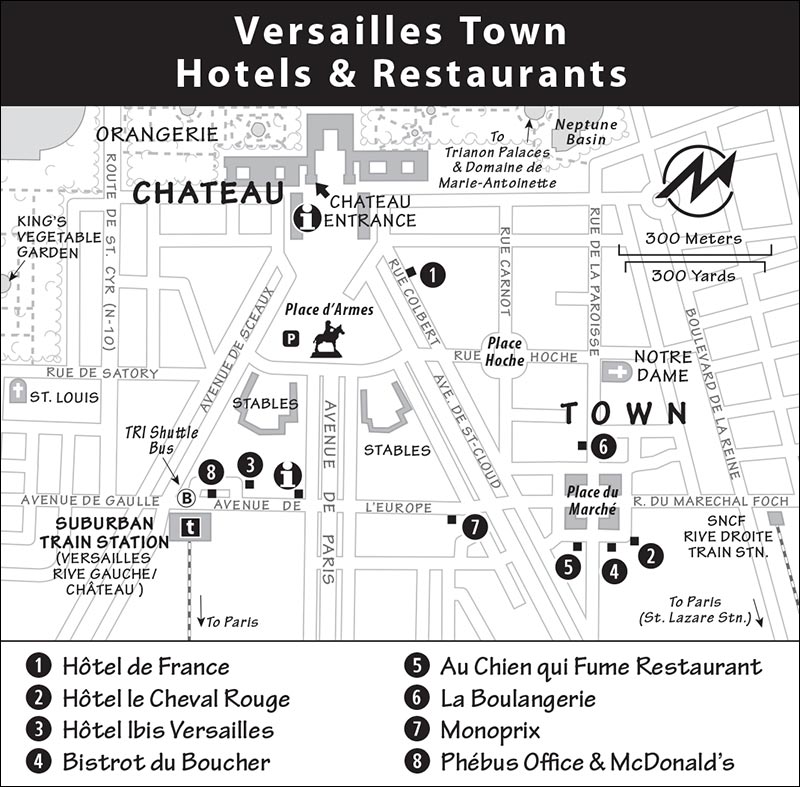
(See “Versailles Town Hotels & Restaurants” map.)
The Place du Marché Notre-Dame market square—a 15-minute walk from the Château (veer left as you leave the Château)—is lined with colorful and inexpensive eateries with good seating inside and out. Troll the various options or try one of these:
$$$ Bistrot du Boucher reeks with fun character inside and has good seating outside. They like their meat dishes best here, though you’ll find a full menu of choices (bargain lunch menu, daily, 12 Rue André Chénier, tel. 01 39 02 12 15, Nolan).
$$ Au Chien qui Fume is a decent choice, with cozy seating inside and out, a playful staff, and reliable, traditional cuisine (lunch deals, closed Sun, 72 Rue de la Paroisse, tel. 01 39 53 14 56).
$ La Boulangerie has mouthwatering sandwiches, salads, quiches, and more (Tue-Sat until 20:00, Sun until 13:30, closed Mon, 60 Rue de la Paroisse).
Breakfast: The Hôtel Ibis Versailles, across from the train station, offers a good buffet breakfast daily until 10:00 (€10.50). It’s great for early birds who want to fuel up before sightseeing.
Supermarket: A big Monoprix is centrally located between the Versailles Rive Gauche/Château train station and Place du Marché Notre-Dame (entrances from Avenue de l’Europe and at 5 Rue Georges Clemenceau, Mon-Sat 8:30-21:00, closed Sun).
Chartres, about 50 miles southwest of Paris, gives travelers a pleasant break in a lively, midsize town with a thriving, pedestrian-friendly old center. But the big reason to come to Chartres (shar-truh) is to see its famous cathedral—arguably Europe’s best example of pure Gothic.
Chartres’ old church burned to the ground on June 10, 1194. Some of the children who watched its destruction were actually around to help rebuild the cathedral and attend its dedication Mass in 1260. That’s astonishing, considering that other Gothic cathedrals, such as Paris’ Notre-Dame, took literally centuries to build. Having been built so quickly, the cathedral has a unity of architecture, statuary, and stained glass that captures the spirit of the Age of Faith like no other church.

Chartres is an easy day trip from Paris (even if you leave Paris in the afternoon and return later in the evening). But with its statues glowing in the setting sun—and with hotels and restaurants much less expensive than those in the capital—Chartres also makes a worthwhile overnight stop. If you’ll be here at night, don’t miss the dazzling light show—Chartres en Lumières—when dozens of Chartres’ most historic buildings are colorfully illuminated, adding to the town’s after-hours appeal (mid-April-mid-Oct; details at TI). Chartres’ historic center is quiet Sunday and Monday, when most shops are closed.
Chartres is a one-hour ride from Paris’ Gare Montparnasse (14/day, about €16 one-way; see the “Paris Connections” section of the previous chapter for Gare Montparnasse details). Jot down return times to Paris before you exit the Chartres train station (last train generally departs Chartres around 21:30).
Upon arrival in Chartres, head for the cathedral. Allow an hour to savor the church on your own as you follow my self-guided tour. But don’t miss the mesmerizing cathedral tour at noon led by Malcolm Miller; also consider the informative tour at 14:45 by Anne-Marie Woods (details on both tours later). Take another hour or two to wander the appealing old city. On Saturday and Wednesday mornings, a small outdoor market sets up a few short blocks from the cathedral on Place Billard.
Tourist Information: The TI is in the historic Maison du Saumon building (Mon-Sat 10:00-18:00, Sun until 17:00, closes earlier Nov-March, 8 Rue de la Poissonnerie, tel. 02 37 18 26 26, www.chartres-tourisme.com). It offers specifics on cathedral tours and also rents audioguides for the old town (€5.50, €8.50/double set, about 2 hours). Skip the Chartres Pass sold here.
The TI has a small map that shows the floodlit Chartres en Lumières sites, and information on the Petit Train you can take to see them all (check the website or ask at the TI for details).
Arrival in Chartres: Exiting Chartres’ train station, you’ll see the spires of the cathedral dominating the town. It’s a 10-minute walk up Avenue Jehan de Beauce to the cathedral. The free minibus, called the Filibus, runs to near the cathedral (line: Relais des Portes, 3/hour, Mon-Sat 8:30-19:00), or you can take a taxi for about €7. The last train to Paris usually leaves around 21:30 (verify for your day of travel).
If arriving by car, you’ll have fine views of the cathedral and city as you approach from the A-11 autoroute. Pay underground parking is on Place des Epars and Place Châtelet, both a short walk from the cathedral. Free parking is available in the lower medieval town (Parking Trois Détours), a 15-minute uphill walk to the cathedral following my Chartres Walk.
Helpful Hints: To get online, try the free Chartres Wi-Fi on Place des Epars or Place Châtelet. A launderette is a few blocks from the cathedral (by the TI) at 16a Place de la Poissonnerie (daily 7:00-21:00). If you need to call a taxi, try tel. 02 37 36 00 00.
(See “Chartres Cathedral” map.)
The church is (at least) the fourth one on this spot dedicated to Mary, the mother of Jesus, who has been venerated here for some 1,700 years. There’s even speculation that the pagan Romans dedicated a temple here to a mother-goddess. In earliest times, Mary was honored next to a natural spring of healing waters (not visible today).
In 876, the church acquired the torn veil (or birthing gown) supposedly worn by Mary when she gave birth to Jesus. The 2,000-year-old veil (now on display) became the focus of worship at the church. By the 11th century, the cult of saints was strong. And Mary, considered the “Queen of All Saints,” was hugely popular. God was enigmatic and scary, but Mary was maternal and accessible, providing a handy go-between for Christians and their Creator. Chartres, a small town of 10,000 with a prized relic, found itself in the big time on the pilgrim circuit.
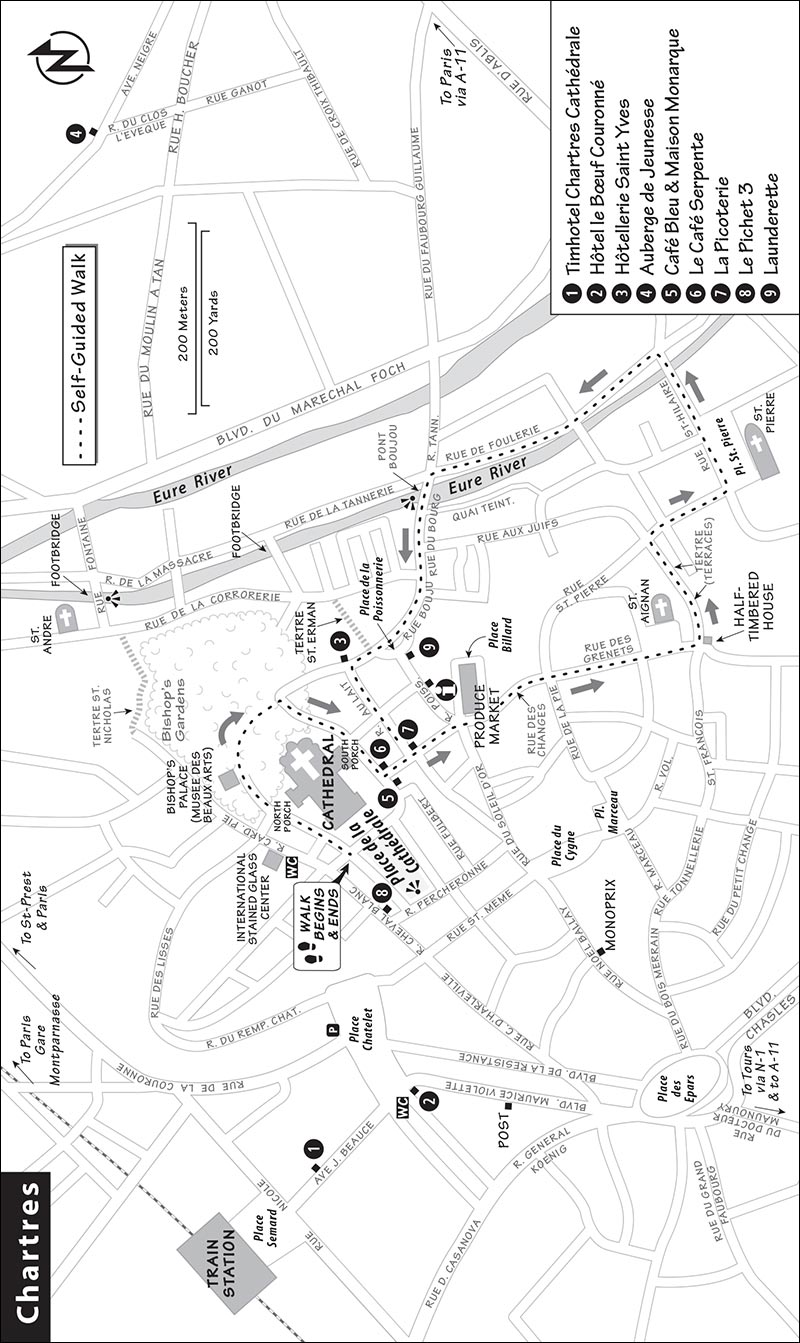
When the fire of 1194 incinerated the old church, the veil was feared lost. Lo and behold, several days later, townspeople found it miraculously unharmed in the crypt (beneath today’s choir). Whether the veil’s survival was a miracle or a marketing ploy, the people of Chartres were so stoked, they worked like madmen to erect this grand cathedral in which to display it. Thinkers and scholars gathered here, making the small town with its big-city church a leading center of learning in the Middle Ages (until the focus shifted to Paris’ university).
By the way, the church is officially called the Cathédrale Notre-Dame de Chartres. Many travelers think that “Notre-Dame” is in Paris. That’s true. But more than a hundred churches dedicated to Mary—“Notre-Dames”—are scattered around France, and Chartres Cathedral is one of them.
Cathedral: Free to enter, open daily 8:30-19:30. Mass usually Mon-Sat at 11:45 (in the crypt), daily at 18:00, plus Sun also at 9:00 (Gregorian) and 11:00. Confirm times by phone or online—tel. 02 37 21 59 08, www.cathedrale-chartres.org (click “Infos Pratiques,” then “Horaires des Messes”).

Cathedral Tours: A fascinating English scholar who moved here almost 60 years ago at age 24, Malcolm Miller has dedicated his life to studying this cathedral and sharing its wonder through his guided lecture tours. He’s slowing down a bit, but his 1.25-hour tours are still riveting even if you’ve taken my self-guided tour. No reservation is needed; just show up with cash (€10, €5 for students, includes headphones that allow him to speak softly, Easter-mid-Oct Mon-Sat at 12:00; no tours last half of Aug, on religious holidays, or if fewer than 12 people show up). Tours begin just inside the church at the Visites de la Cathédrale sign. Consult this sign for changes or cancellations. He also offers private tours (millerchartres@aol.com). Miller’s guidebook provides a detailed look at Chartres’ windows, sculpture, and history (sold at cathedral).
Charming American expat Anne-Marie Woods is Malcom Miller’s understudy and is equally passionate about the cathedral. She leads worthwhile 1.5-hour tours of the cathedral that include the vast crypt (daily at 14:45, meet inside gift shop, tel. 02 37 21 75 02, www.cathedrale-chartres.org).
You can rent a videoguide to the right as you enter the cathedral, a good way to get a closer look at the window details (€7, 70 minutes). Binoculars are a big help for studying the cathedral art (rent at souvenir shops around the cathedral).
Tower Climb: €6 to climb the 200 steps to the rooftop with a French-only guided tour; daily May-Aug at 11:00, 14:30, and 16:00, Sept-April at 11:00 and 15:00; call ahead at tel. 02 37 21 22 07 as this may change due to renovations.
Crypt: Beneath the cathedral are extensive remnants of earlier churches, a modern copy of the old wooden Mary-and-baby statue, an amazing 2,000-year-old well, and frescoes from the 12th and 13th centuries. The only way to see the crypt is on a tour. Anne-Marie Woods’ tour (see above) includes the crypt and helps bring it to life, but I’d avoid the more frequent 30-minute tours in French with English handout (€4, 5/day late June-mid-Sept, fewer Sun and off-season, book at cathedral gift shop, tel. 02 37 21 75 02).
Restoration: A multiyear restoration is underway, though you should see few signs of it in 2019.
 Self-Guided Tour: Historian Malcolm Miller calls Chartres a picture book of the entire Christian story, told through its statues, stained glass, and architecture. In this “Book of Chartres,” the text is the sculpture and windows, and its binding is the architecture. The complete narrative can be read—from Creation to Christ’s birth (north side of church), from Christ and his followers up to the present (south entrance), and then to the end of time, when Christ returns as judge (west entrance). The remarkable cohesiveness of the text and the unity of the architecture are due to the fact that nearly the entire church was rebuilt in just 30 years (a blink of an eye for cathedral building).
Self-Guided Tour: Historian Malcolm Miller calls Chartres a picture book of the entire Christian story, told through its statues, stained glass, and architecture. In this “Book of Chartres,” the text is the sculpture and windows, and its binding is the architecture. The complete narrative can be read—from Creation to Christ’s birth (north side of church), from Christ and his followers up to the present (south entrance), and then to the end of time, when Christ returns as judge (west entrance). The remarkable cohesiveness of the text and the unity of the architecture are due to the fact that nearly the entire church was rebuilt in just 30 years (a blink of an eye for cathedral building).
• Start outside, taking in the...
1 Main Entrance (West Facade): Chartres’ soaring (if mismatched) steeples announce to pilgrims that they’ve arrived. Compare the towers. The right (south) tower, with a Romanesque stone steeple, survived the fire. The left (north) tower lost its wooden steeple in the fire. In the 1500s, it was topped with the flamboyant Gothic steeple we see today.
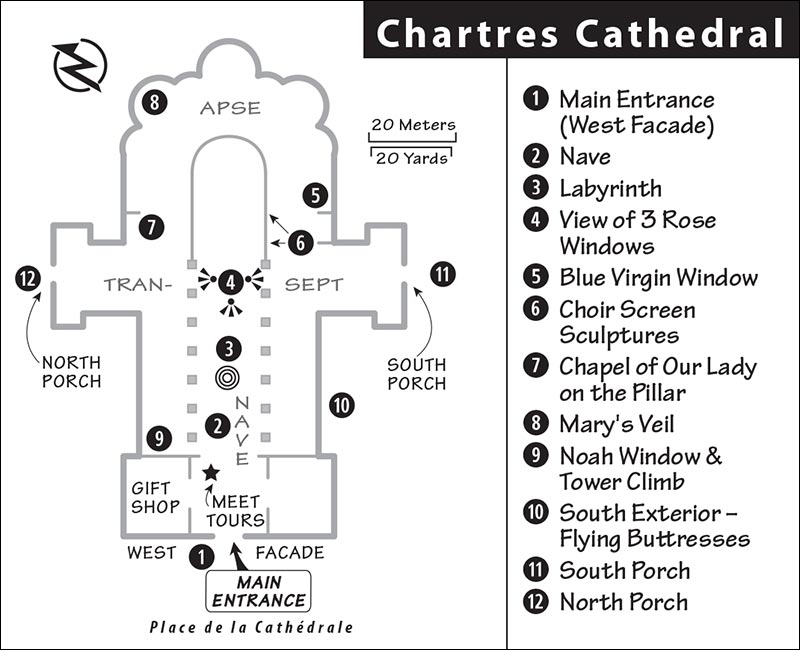
• Enter the church (from a side entrance if the main one is closed) and wait for your pupils to enlarge.
2 Nave: The place is huge—the nave is 427 feet long, 20 feet wide, and 120 feet high. Try to picture the church in the Middle Ages—painted in greens, browns, and golds (like colorful St. Aignan Church in the old town). It was packed with pilgrims, and was a rough cross between a hostel, a soup kitchen, and a flea market. Taking it all in from the nave, notice that, as was typical in medieval churches, the windows on the darker north side feature Old Testament themes—awaiting the light of Christ’s arrival. And the windows on the brighter south side are New Testament.
• On the floor, midway up the nave, find the...
3 Labyrinth: The broad, round labyrinth inlaid in black marble on the floor is a spiritual journey. Labyrinths like this were common in medieval churches. Pilgrims enter from the west rim, by foot or on their knees, and wind around, meditating, on a metaphorical journey to Jerusalem. About 900 feet later, they hope to meet God in the middle.
• Walk up the nave to where the transept crosses. As you face the altar and gleaming choir, north is to the left.
4 The Rose Windows: The three big, round “rose” (flower-shaped) windows over the entrances receive sunlight at different times of day. All three are predominantly blue and red, but each has different “petals,” and each tells a different part of the Christian story in a kaleidoscope of fragmented images.
The brilliantly restored north rose window charts history from the distant past up to the birth of Jesus. The south rose window, with a similar overall design, tells how the Old Testament prophecies were fulfilled. Christ sits in the center (dressed in blue, with a red background), setting in motion radiating rings of angels, beasts, and instrument-playing apocalyptic elders who labor to bring history to its close. In the center of the west rose window, a dark Christ rings in history’s final Day of Judgment. Around him, winged angels blow their trumpets and the dead rise, face judgment, and are sent to hell or raised to eternal bliss.
• Now walk around the altar to the right (south) side and find the window with a big, blue Mary (second one from the right).
5 The Blue Virgin Window: Mary, dressed in blue on a rich red background, cradles Jesus, while the dove of the Holy Spirit descends on her. This very old window (mid-12th century) was the central window behind the altar of the church that burned in 1194. It survived and was reinserted into this frame in the new church around 1230. Mary’s glowing dress is an example of the famed “Chartres blue,” a sumptuous color made by mixing cobalt oxide into the glass (before cheaper materials were introduced).
• Now turn around and look behind you.
6 The Choir Screen: Life of Mary: The choir (enclosed area around the altar where church officials sat) is the heart (coeur) of the church. A stone screen rings it with 41 statue groups illustrating Mary’s life. The plain windows surrounding the choir date from the 1770s, when the dark mystery of medieval stained glass was replaced by the open light of the French Enlightenment.
• Do an about-face and find the chapel with Mary on a pillar.
7 Chapel of Our Lady on the Pillar: A 16th-century statue of Mary and baby—draped in cloth, crowned and sceptered—sits on a 13th-century column in a wonderful carved-wood alcove. This is today’s pilgrimage center, built to keep visitors from clogging up the altar area.
• Double back a bit around the ambulatory, heading toward the back of the church. In the next chapel you encounter (Chapel of the Sacred Heart of Mary), you’ll find a gold frame holding a fragment of Mary’s venerated veil. These days it’s kept—for its safety and preservation—out of the light and behind bulletproof glass.
8 Mary’s Veil: This veil (or tunic) was supposedly worn by Mary when she gave birth to Jesus. In the frenzy surrounding the fire of 1194, the veil mysteriously disappeared, only to reappear three days later (recalling the Resurrection). This was interpreted by church officials and the townsfolk as a sign from Mary that she wanted a new church, and thus the building began.
• Return to the west end and find the last window on the right (near the tower entrance).
9 The Noah Window and Tower Climb: Read Chartres’ windows in the medieval style: from bottom to top. In the bottom diamond, God tells Noah he’ll destroy the earth. Next, Noah hefts an axe to build an ark, while his son hauls wood (diamond #2). Two by two, he loads horses (cloverleaf, above left), purple elephants (cloverleaf, right), and other animals. The psychedelic ark sets sail (diamond #3). Waves cover the earth and drown the wicked (two cloverleafs). The ark survives (diamond #4), and Noah releases a dove. Finally, up near the top (diamond #7), a rainbow (symbolizing God’s promise never to bring another flood) arches overhead, God drapes himself over it, and Noah and his family give thanks.
• To climb the north tower, you’ll need to join a tour (see here). Then exit the church through the main entrance or the door in the south transept to view its south side.
10 South Exterior: Flying Buttresses: Six flying buttresses (the arches that stick out from the upper walls) push against six pillars lining the nave inside, helping to hold up the heavy stone ceiling and sloped, lead-over-wood roof. The result is a tall cathedral held up by slender pillars buttressed from the outside, allowing the walls to be opened up for stained glass.
11 South Porch: The three doorways of the south entrance show the world from Christ’s time to the present, as Christianity triumphs over persecution. On the center door, Jesus holds a book and raises his arm in blessing. He’s a simple, itinerant, bareheaded, barefoot rabbi, but underneath his feet, he tramples symbols of evil: the dragon and lion. Christ is surrounded by his apostles, who spread the good news to a hostile world.
The final triumph comes above the door in the Last Judgment. Christ sits in judgment, raising his hands, while Mary and John beg him to take it easy on poor humankind. Beneath Christ the souls are judged—the righteous on our left, and the wicked on our right, who are thrown into the fiery jaws of hell.
• Reach the north side by circling around the back end of the church.
12 North Porch: In the “Book of Chartres,” the north porch is chapter one, from the Creation up to the coming of Christ. Imagine all this painted and covered with gold leaf in preparation for the dedication ceremonies in 1260, when the Chartres generation could finally stand back and watch as their great-grandchildren, carrying candles, entered the cathedral.
Chartres’ old town bustles with activity (except Sun and Mon) and merits exploration. You can rent an audioguide from the TI, or better, just wander (follow the route shown on the map on here).
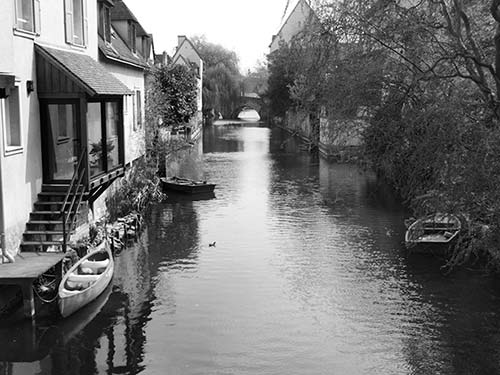
In medieval times, Chartres was actually two towns—the pilgrims’ town around the cathedral, and the industrial town along the river, which was powered by watermills. An easy 45-minute loop takes you around the cathedral, through the old pilgrims’ town, down along the once-industrial riverbank, and back to the cathedral. Along the way you’ll discover a picnic-perfect park behind the cathedral, see the colorful pedestrian zone, and wander quiet alleys and peaceful lanes.
This low-key center on the north side of the cathedral is worth a visit to learn about the techniques behind the mystery of this fragile but enduring art. Panels describe the displays, many of which are original windows. Ask at the entrance about the 25-minute video in English describing the process of blown glass and the 10-minute French-only video explaining how it is turned into stained glass (easy to follow for non-French speakers). The center also offers five-day classes; call ahead or email for topics and dates.
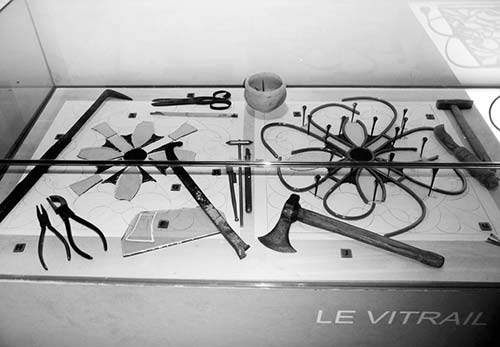
Cost and Hours: €7, Mon-Fri 9:30-12:30 & 13:30-17:45, Sat from 10:00 & 14:30, Sun 14:30-17:45, 5 Rue du Cardinal Pie, 50 yards from cathedral, tel. 02 37 21 65 72, www.centre-vitrail.org.
$$ Timhotel Chartres Cathédrale,*** a block up from the train station, is comfortable and well run. Don’t let the facade fool you—inside is a comfy place with a huge fireplace in the lobby and 48 well-kept rooms. Several rooms connect—good for families—and many have partial cathedral views (good buffet breakfast—extra, but one breakfast per couple free for Rick Steves readers; minibars, elevator, air-con, handy and safe pay parking, 6 Avenue Jehan de Beauce, tel. 02 37 21 78 00, www.timhotel.com, chartres@timhotel.fr).
$ Hôtel le Bœuf Couronné*** is more like a vintage two-star hotel, with 17 colorful, good-value rooms and a handy location halfway between the station and cathedral (elevator, no air-con, good restaurant with views of the cathedral, reserve ahead for pay parking, 15 Place Châtelet, tel. 02 37 18 06 06, www.leboeufcouronne.com, resa@leboeufcouronne.fr).
$ Hôtellerie Saint Yves, which hangs on the hillside just behind the cathedral, delivers well-priced simplicity with 50 spic-and-span rooms in a renovated monastery with meditative garden areas. Single rooms have no view; ask for a double room with views of the lower town (small bathrooms, good breakfast—extra, 3 Rue des Acacias, tel. 02 37 88 37 40, www.maison-st-yves.com, reception@saintyves.net).
Hostel: A 20-minute walk from the historic center, ¢ Auberge de Jeunesse is located in a modern building with good views of the cathedral from its terrace (includes breakfast, dirt cheap meals, 23 Avenue Neigre, tel. 02 37 34 27 64, www.auberge-de-jeunesse-chartres.fr, auberge-jeunesse-chartres@wanadoo.fr).
Dining out in Chartres is a good deal—particularly if you’ve come from Paris. Troll the places basking in cathedral views, and if it’s warm, find a terrace table (several possibilities). Then finish your evening cathedral-side, sipping a hot or cold drink at Le Serpente.
$$ Café Bleu offers a great view terrace and an appealing interior. It serves classic French fare at acceptable prices (closed Tue, 1 Cloître Notre-Dame, tel. 02 37 36 59 60).
$$ Le Café Serpente saddles up next door to the cathedral, with terrific view tables and an adorable collector’s interior. The cuisine is good, basic bistro fare and fairly priced. Simple dishes and to-go food are available from the room at the back (daily, 2 Cloître Notre-Dame, tel. 02 37 21 68 81).
$ La Picoterie efficiently serves up inexpensive fare such as omelets, crêpes, and salads in its cozy dining room (daily, 36 Rue des Changes, tel. 02 37 36 14 54).
$$ Le Pichet 3 is run by endearing Marie-Sylvie and Xavier. This local-products shop and snug bistro make a fun stop. Sit on the quiet terrace or peruse the artsy inside. Laura—the daughter—serves a tasty assiette végétarienne and a good selection of plats. Try the local specialty, la poule au pot, and the rabbit with plums (Thu-Mon, closed Mon evening and all day Tue-Wed, 19 Rue du Cheval Blanc, tel. 02 37 21 08 35).
$ Maison Monarque offers decadent pastries and light lunches with a cathedral view (closed Mon-Tue, 49 Rue des Changes, tel. 02 34 40 04 00).
Claude Monet’s gardens at Giverny are like his paintings—brightly colored patches that are messy but balanced. Flowers were his brushstrokes, a bit untamed and slapdash, but part of a carefully composed design. Monet spent his last (and most creative) years cultivating his garden and his art at Giverny (zhee-vayr-nee), the spiritual home of Impressionism. Visiting the Marmottan and/or the Orangerie museums in Paris before your visit here heightens your appreciation of these gardens.
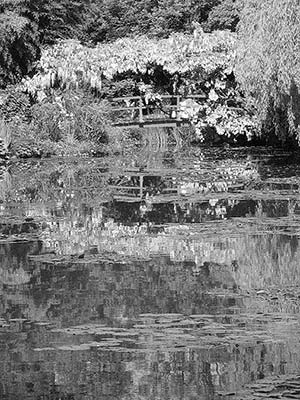
In 1883, middle-aged Claude Monet, his wife Alice, and their eight children from two families settled into this farmhouse, 50 miles west of Paris. Monet, already a famous artist and happiest at home, would spend 40 years in Giverny, traveling less with each passing year. He built a pastoral paradise complete with a Japanese garden and a pond full of floating lilies.
Minivan and big bus tours take groups to Giverny. The trip is also doable in a half-day by car or public transportation by train with a connection by bus, taxi, bike, or hike.
By Tour: Minivan tours will pick you up at your hotel and whisk you painlessly there and back. Paris Webservices tours are best, with informative drivers and ample time to savor the experience (figure around $100/person—see here). Big bus tour companies do a Giverny day trip from Paris for around €50 (5 hours, includes entry, get details at your hotel or www.pariscityvision.com).
By Car: From Paris’ périphérique ring road, follow A-13 toward Rouen, exit at Sortie 14 to Vernon, and follow Centre Ville signs, then signs to Giverny. You can park right at Monet’s house or at one of several nearby lots. Romantics can take the scenic route from the same exit by following tiny D-201 over the river and through the woods.
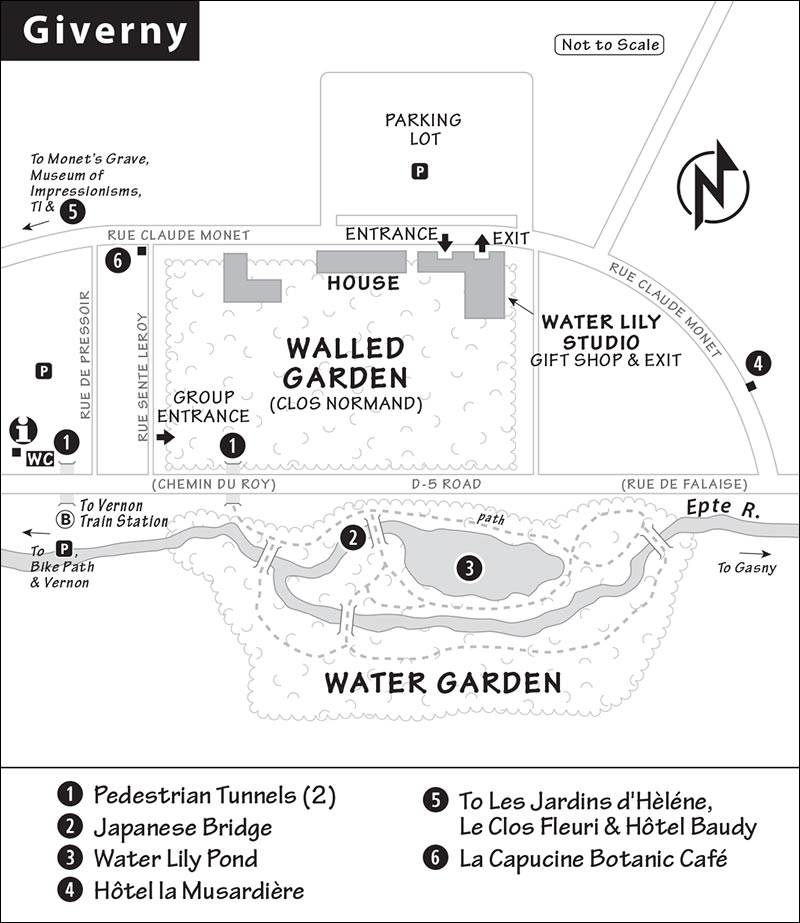
By Train: This option is less expensive than a tour and puts you in charge of your own time, but because trains are not frequent, be prepared for a six-hour excursion. Take the Rouen-bound train from Paris Gare St. Lazare Station to Vernon, about four miles from Giverny (normally leaves from tracks 20-25, 45 minutes, about €30 round-trip). The train that leaves Paris at around 8:15 is ideal for this trip, with departures about every two hours after that (8/day Mon-Sat, 6/day Sun). Before boarding, use an information desk in Gare St. Lazare to get return times from Vernon to Paris.
Getting from Vernon’s Train Station to Giverny: From the Vernon station to Monet’s garden, you have four options: bus, taxi, bike, or hike. The Vernon-Giverny bus works well with most trains from Paris for the 15-minute run to Giverny (generally every 2 hours 9:15-15:15, €10 round-trip, pay driver). A bus-and-train timetable is available at the bus stops, on the bus, and online (www.giverny.org/transpor)—note return times. To reach the bus stop, across from the L’Arrivée de Giverny café, walk through the station and keep straight. Don’t dally in the station—the bus may leave soon after your train arrives.
Returning to the station, the bus leaves Giverny from the same stop where it drops you off (near the pedestrian underpass—see map; TI and good WCs on the north side of the underpass). Buses generally run hourly in the morning and afternoon (every two hours midday, at :10 after the hour, last departure about 19:10, confirm times by checking schedule upon arrival). Get to the stop at least 15 minutes early to ensure a space. If you miss the return bus and can’t wait for the next one, ask any approachable service personnel to call a taxi.
Taxis wait in front of the station in Vernon (allow €15 one-way for up to 3 people). Try Damien Taxi at mobile 06 03 30 85 47 or tel. 02 77 02 94 97 (for other taxis call 06 77 49 32 90 or 06 50 12 21 22).
Another option is to rent a bike at L’Arrivée de Giverny café (opposite the station) and take a 30-minute ride along a well-signed, paved bike path (piste cyclable) that runs from near Vernon along an abandoned railroad right-of-way.
Hikers can go on foot to Giverny (4 level miles, about 1.5 hours one way) following the bike path and take a bus or taxi back.
Extension to Rouen: Consider combining your morning Giverny visit with an afternoon excursion to nearby Rouen—together they make an efficient and memorable day trip from Paris. Note that Rouen’s museums are closed on Tuesdays. From Vernon (the halfway point between Rouen and Paris), it’s about 40 minutes by train to Rouen; the return trip from Rouen back to Paris takes 70-90 minutes. Plan to arrive at Monet’s garden when it opens (at 9:30) so you can be back to the Vernon train station by 13:00. You’ll land in Rouen by 14:00 and have just enough time to see Rouen’s cathedral and surrounding medieval quarter. If you leave Rouen around 18:00, you’ll pull into Paris about 19:15, having spent a wonderful day sampling rural and urban Normandy.
Giverny is a tiny village about four miles from the town of Vernon. All of Giverny’s sights and shops string along Rue Claude Monet, which runs in front of Monet’s house. The TI is located by the WCs in the parking lot near the road to Vernon (see map, daily April-Sept, closed off-season, 80 Rue Claude Monet, tel. 02 32 64 45 01).
There are two gardens, split by a busy road, plus the house, which displays Monet’s prized collection of Japanese prints. The gardens are always flowering with something; they’re at their most colorful April through July.
Cost and Hours: €10.50, not covered by Paris Museum Pass, €17 combo-tickets available with nearby Museum of Impressionisms, €20 with Paris’ Orangerie or Marmottan Museums; daily April-Oct 9:30-18:00, closed Nov-March; tel. 02 32 51 90 31, http://fondation-monet.com.
Crowd-Beating Tips: Though lines may be long and tour groups may trample the flowers, true fans still find magic in the gardens. Minimize crowds by arriving a little before 9:30, when it opens, or come after 16:00 and stay until it closes. The busiest months are May and June. Sunday mornings are busiest in any season when cruise groups arrive in force.
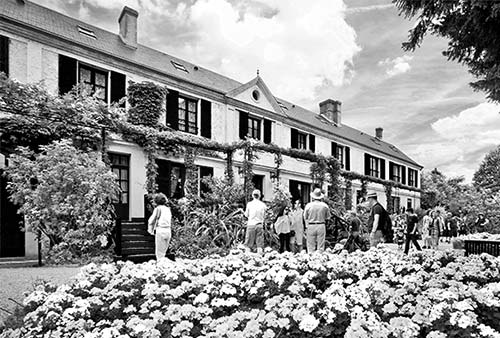
Advance ticket and combo-ticket holders skip the ticket-buying line and use the nifty group entrance, a huge advantage in high season. You can buy advance tickets online or at any FNAC store in Paris. Alternately, buy combo tickets with either the Orangerie or Marmottan Museum in Paris, or the Museum of Impressionisms here (described later).
Guided Tours: Enthusiasts can take a 1.5-hour guided tour of the gardens for €80 (1-4 people, http://giverny.org/guide/ariane/).
Visiting the House and Gardens: There are two parts to the gardens, the Walled Garden (next to the house) and the Water Garden (across the road). Most visitors use the main entry and start in the Walled Garden (Clos Normand). Those able to use the group entrance should start with the Water Garden and end with the Walled Garden and house.

In the Walled Garden, smell the pretty scene. Monet cleared this land of pine trees and laid out symmetrical beds, split down the middle by a “grand alley” covered with iron trellises of climbing roses. He did his own landscaping, installing flowerbeds of lilies, irises, and clematis. In his carefree manner, Monet throws together hollyhocks, daisies, and poppies. The color scheme of each flowerbed contributes to the look of the whole garden.
In the southwest corner of the Walled Garden (near the group entrance), you’ll find a pedestrian tunnel that leads under the road to the Water Garden, with Monet’s famous pond and lilies. Follow the meandering path to the Japanese bridge, under weeping willows, over the pond filled with water lilies, and past countless scenes that leave artists aching for an easel. Find a bench and linger for a while. Monet landscaped like he painted—he built an Impressionist pattern of blocks of color. After he planted the gardens, he painted them, from every angle, at every time of day, in all kinds of weather.
End your visit with a wander through Monet’s charming, I-could-retire-here home, with pretty furnishings, Japanese prints, old photos, and rooms filled with copies of his and other artists’ paintings. The gift shop at the exit is the actual sky-lighted studio where Monet painted his masterpieces (displayed at the Orangerie Museum in Paris). Many visitors spend more time in this tempting gift shop than in the gardens themselves.
The village is a sight in itself, with flowery lanes home to a few souvenir shops, art galleries, and cafés. Cars are not allowed to enter the center of the village.
This bright, modern museum, dedicated to the history of Impressionism and its legacy, houses temporary exhibits of Impressionist art. Check its website for current shows or just drop in. Meander through its colorful, picnic-friendly gardens for more color.
Cost and Hours: €7.50, €17 combo-ticket with Monet’s Garden and House, daily April-Oct 10:00-18:00, closed Nov-March; to reach it, turn left after leaving Monet’s place and walk 200 yards; tel. 02 32 51 94 00, www.mdig.fr.
Monet’s grave is a 15-minute walk from his door. Turn left out of his house and walk down Rue Claude Monet, pass the Museum of Impressionisms and the Hôtel Baudy, and find it in the backyard of the white church Monet attended (Eglise Sainte-Radegonde). Look for flowers, with a cross above. The inscription says: Here lies our beloved Claude Monet, born 14 November 1840, died 5 December 1926; missed by all.
If you have time to kill at Vernon’s train station, take a five-minute walk into town and sample the peaceful village. From the station, pass the Café de l’Arrivée on your left, follow the street as it curves left, and keep straight. You’ll find a smattering of half-timbered Norman homes near Hôtel de Ville (remember, you’re in Normandy), several good cafés and shops, and the town’s towering Gothic church.
Sleeping: $ Hôtel la Musardière** is nestled in the village of Giverny two blocks from Monet’s home (exit right when you leave Monet’s) with 10 sweet rooms that Claude himself would have felt at home in (family rooms available). There’s also a reasonable and homey $ crêperie-restaurant with outdoor tables (daily with nonstop service, 123 Rue Claude Monet, tel. 02 32 21 03 18, www.lamusardiere.fr, hotelmusardieregiverny@wanadoo.fr).
$$ Les Jardins d’Hèléne chambres d’hôte is a warm, comfy place with good public spaces, floral rooms, and a large garden. Owner Isabelle makes a good host (includes breakfast, cash only, 15-minute walk from Monet’s home at 12 Rue Claude Monet, tel. 02 32 21 30 68 or 06 47 98 14 87, www.giverny-lesjardinsdhelene.com, lesjardinsdhelene@outlook.com).
$ Le Clos Fleuri is a family-friendly B&B with three spacious and very comfortable rooms, each with a king-size bed and a private terrace facing the grassy garden. The rooms also share handy cooking facilities. It’s a 15-minute walk from Monet’s place and is run by charming, English-speaking Danielle (with Australian heritage), who serves up a good included breakfast (cash only, 5 Rue de la Dîme, tel. 02 32 21 36 51, www.giverny-leclosfleuri.fr, leclosfleuri27@yahoo.fr).

Eating: You’ll find various snack places just outside the entrance to Monet’s home. Your best lunch option is a block to the left at $ La Capucine self-serve restaurant. Eat tasty, cheap soups, salads, and quiches at a table in the warm interior or the welcoming garden (daily 10:00-18:00).
Rose-colored $$ Hôtel Baudy, once a hangout for American Impressionists, offers an appropriately pretty setting for lunch or dinner. The decor looks as though it has not changed since painters hung their brushes here (outdoor tables in front, good-value menus, popular with tour groups at lunch, daily, 5-minute walk past Museum of Impressionisms at 81 Rue Claude Monet, tel. 02 32 21 10 03). Don’t miss a stroll through the artsy gardens behind the restaurant.
Europe’s Disneyland is a remake of California’s, with most of the same rides and smiles. The main difference is that Mickey Mouse speaks French, and you can buy wine with your lunch. My kids went ducky for it.
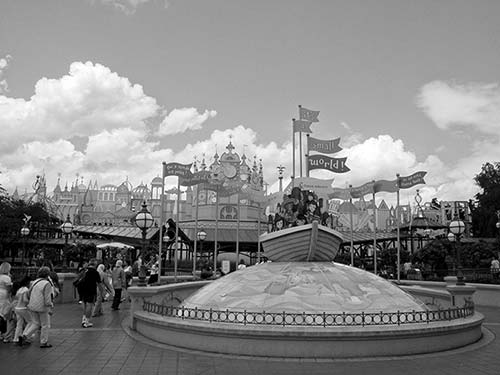
The Disneyland Paris Resort is a sprawling complex housing two theme parks (Disneyland Paris and Walt Disney Studios), a few entertainment venues, and several hotels. With upwards of 15 million visitors a year, it is Europe’s single leading tourist destination.
Disneyland Paris: This park has cornered the fun market, with classic rides and Disney characters. You’ll find familiar favorites wrapped in French packaging, like Space Mountain (a.k.a. De la Terre à la Lune) and Pirates of the Caribbean (Pirates des Caraïbes).
Walt Disney Studios: This zone has a Hollywood focus geared for an older crowd, with animation, special effects, and movie magic “rides.” The cinema-themed rides include the Studio Tram Tour: Behind the Magic (a slow-motion ride that goes mostly outdoors through a “movie backlot”); and Moteurs... Action! Stunt Show Spectacular (an actual movie sequence is filmed with stunt drivers, audience bit players, and brash MTV-style hosts). The top thrill rides include the Rock ’n’ Roller Coaster (which starts out by accelerating from a standstill to nearly 60 miles per hour in less than three seconds), and the Twilight Zone Tower of Terror (which drops passengers from a precarious 200-foot-high perch). Gentler attractions include a re-creation of the parachute jump in Toy Story and a Finding Nemo-themed ride (Crush’s Coaster) that whisks you through the ocean current.
Disneyland is easy to get to, and may be worth a day—if Paris is handier than Florida or California.
By Bus or Train from Downtown Paris: The slick 45-minute RER/Train-A trip is the best way to get to Disneyland from Paris. Take the train to Marne-la-Vallée-Chessy (check the signs over the platform to be sure Marne-la-Vallée-Chessy is served, because the line splits near the end). Catch it from one of these stations: Charles de Gaulle-Etoile, Auber, Châtelet-Les Halles, or Gare de Lyon (at least 3/hour, drops you 45 minutes later right in the park, about €9 each way). The last train back to Paris leaves shortly after midnight. When returning, remember to use the same RER/Train-A ticket for your Métro connection in Paris.
The all-day Mobilis ticket is a smart purchase for some Disney day-trippers, as it covers your Paris Métro rides for the day and the round-trip train to Disneyland (about €18 for zones 1-5 ticket). Buy it at any Métro station, fill in your name and date of travel on the ticket, and validate it the day you use it.
Disneyland Express runs buses to Disneyland from several stops in central Paris (including Opéra, Madeleine, Châtelet, and Gare du Nord). A single ticket combines transportation and entrance to Disneyland (about €90 for ages 3-11, free for ages 2 and under, €95 for adults; several morning departures to choose from and one return time of 20:00, book tickets online, www.disneylandparis-express.com).
By Bus or Train from the Airport: Both of Paris’ major airports (Charles de Gaulle and Orly) have direct shuttle buses to Disneyland Paris (€23; about hourly and takes 45 minutes, www.magicalshuttle.co.uk). Fast TGV trains (also called “InOui”) run from Charles de Gaulle to Disneyland in 10 minutes, leaving hourly (shuttle bus ride required to get from train station to Disneyland).
By Car: Disneyland is about 40 minutes (20 miles) east of Paris on the A-4 autoroute (direction Nancy/Metz, exit #14). Parking is about €15/day at the park.
Cost: A variety of single and multiday tickets and packages (including transportation, lodging, and/or meals) are sold for Disneyland Paris and/or Walt Disney Studios. Regular prices are discounted about 25 percent Nov-March, and promotions are offered occasionally (check www.disneylandparis.com).
Hours: Disneyland—daily 10:00-22:00, mid-May-Aug until 23:00, until 20:00 in winter, open later on weekends, hours fluctuate with the seasons—check website for precise times. Walt Disney Studios—daily 10:00-19:00.
Skipping Lines: The free Fastpass system is a worthwhile timesaver for the most popular rides (see website for details). At the ride, check the Fastpass sign to see when you can return and skip the line. Insert your park admission ticket into the Fastpass machine, which spits out a ticket printed with your return time. You’ll also save time by buying park tickets in advance (at airport TIs, some Métro stations, or along the Champs-Elysées at the Disney Store).
Avoiding Crowds: Saturday, Sunday, Wednesday, public holidays, and any day in July and August are the most crowded. After dinner, crowds are gone.
Information: Disney brochures are in every Paris hotel. For more info and to make reservations, call 01 60 30 60 53, or try www.disneylandparis.com.
Eating with Mickey: Food is fun and not outrageously priced. (Still, many smuggle in a picnic.) The Disneyland Hotel restaurant Inventions offers an expensive gourmet brunch on Sundays (roughly €60/person) and daily dinners where the most famous Disney characters visit with starstruck eaters.
Most are better off sleeping in the real world (i.e., Paris), though with direct buses and freeways to both airports, Disneyland makes a convenient first- or last-night stop. Seven different Disney-owned hotels offer accommodations at or near the park in all price ranges. Prices are impossible to pin down, as they vary by season and by the package deal you choose (deals that include park entry are usually a better value, with more in the $$$$ range). To reserve any Disneyland hotel, call 01 60 30 60 53, or check www.disneylandparis.com. The prices you’ll be quoted include entry to the park. Hotel Cheyenne** and Hotel Santa Fe** offer fair midrange values, with frequent shuttle service to the park (or a 20-minute walk). A cheaper option is Davy Crockett’s Ranch Hotel, but you’ll need a car to stay there. The most expensive is the Disneyland Hotel,**** right at the park entry, about three times the price of the Santa Fe. The Vienna House Dream Castle Hotel**** is another higher-end choice, with nearly 400 rooms done up to look like a lavish 17th-century palace (40 Avenue de la Fosse des Pressoirs, tel. 01 64 17 90 00, www.dreamcastle-hotel.com, info@dreamcastle-hotel.com).